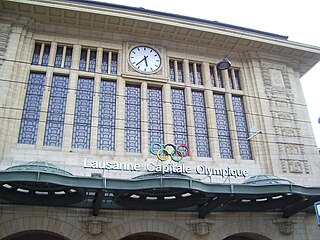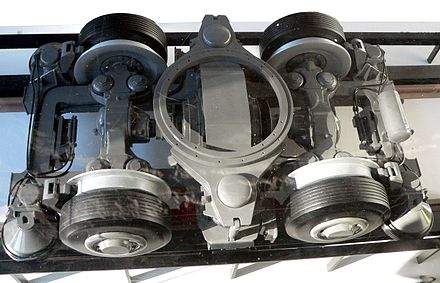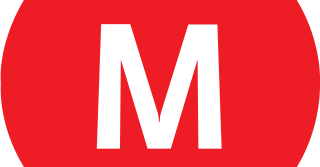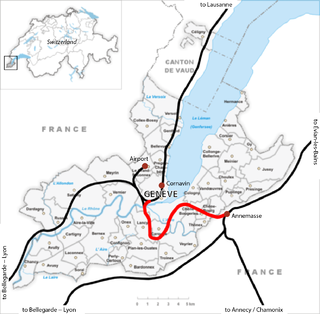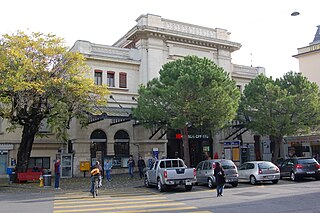This article may be expanded with text translated from the corresponding article in French. (September 2012)Click [show] for important translation instructions.
|
 | |||
| Overview | |||
|---|---|---|---|
| Native name | Métro de Lausanne(in French) | ||
| Locale | Lausanne, Vaud, Switzerland | ||
| Transit type | light rail (Line M1) rapid transit (Line M2) | ||
| Number of lines | 2 | ||
| Number of stations | 28 | ||
| Annual ridership | 40.8 million (2013) [1] | ||
| Website | Transports Lausannois (TL) (in French) | ||
| Operation | |||
| Began operation | 1991 (Line M1) 2008 (Line M2) | ||
| Operator(s) | TL | ||
| Number of vehicles | 40 | ||
| Technical | |||
| System length | M1: 7.8 km (4.8 mi) [2] M2: 5.9 km (3.7 mi) [1] 13.7 km (8.5 mi) (Total) | ||
| Track gauge | 1,435 mm (4 ft 8 1⁄2 in) standard gauge | ||
| Electrification | yes | ||
| |||
The Lausanne Metro system is an urban rail transport system in Lausanne, Switzerland, which operates driverless rapid transit services on a grade-separated route. Around a quarter of the system has been used for urban rail transport since 1877, when the route between the city centre and Ouchy opened as Switzerland's first public funicular railway. The network is owned by two distinct companies and operated by a third.

Lausanne is a city in the French-speaking part of Switzerland, and the capital and biggest city of the canton of Vaud. The city is situated on the shores of Lake Geneva. It faces the French town of Évian-les-Bains, with the Jura Mountains to its north-west. Lausanne is located 62 kilometres northeast of Geneva.

Switzerland, officially the Swiss Confederation, is a country situated in western, central, and southern Europe. It consists of 26 cantons, and the city of Bern is the seat of the federal authorities. The sovereign state is a federal republic bordered by Italy to the south, France to the west, Germany to the north, and Austria and Liechtenstein to the east. Switzerland is a landlocked country geographically divided between the Alps, the Swiss Plateau and the Jura, spanning a total area of 41,285 km2 (15,940 sq mi). While the Alps occupy the greater part of the territory, the Swiss population of approximately 8.5 million people is concentrated mostly on the plateau, where the largest cities are to be found: among them are the two global cities and economic centres Zürich and Geneva.

Rapid transit or mass rapid transit (MRT), also known as heavy rail, metro, subway, tube, U-Bahn or underground, is a type of high-capacity public transport generally found in urban areas. Unlike buses or trams, rapid transit systems are electric railways that operate on an exclusive right-of-way, which cannot be accessed by pedestrians or other vehicles of any sort, and which is often grade separated in tunnels or on elevated railways.
Contents
- History
- Former Lausanne-Ouchy line
- Current service
- Line M1
- Line M2
- Future service
- Line M3
- See also
- Notes and references
- External links
Of the operating line, this is a fully automated metro [3] which opened on 27 October 2008. When this opened, Lausanne replaced Rennes as the smallest city in the world to have a full metro system. [4] A second line is now planned, based on the same rubber-tyred metro technology. This makes Lausanne the first and (as of 2019) the only city in Switzerland to have a metro system, although Zürich once proposed a U-Bahn system in the 1960s and 70s, which failed in the face of massive political and public opposition.

Rennes is a city in the east of Brittany in northwestern France at the confluence of the Ille and the Vilaine. Rennes is the capital of the region of Brittany, as well as the Ille-et-Vilaine department.

A rubber-tyred metro or rubber-tired metro is a form of rapid transit system that uses a mix of road and rail technology. The vehicles have wheels with rubber tires that run on rolling pads inside guide bars for traction, as well as traditional railway steel wheels with deep flanges on steel tracks for guidance through conventional switches as well as guidance in case a tyre fails. Most rubber-tyred trains are purpose-built and designed for the system on which they operate. Guided buses are sometimes referred to as 'trams on tyres', and compared to rubber-tyred metros.

The Zürich Underground Railway, or Zürich U-Bahn, was a project started in the 1970s to build a rapid transit network in the Swiss city of Zürich and several bordering municipalities. This project was itself preceded by several earlier plans dating from between 1864 and 1959. In April 1962, the "Tiefbahn" project was proposed, which would have included placing the Zürich trams underground in the city centre by building 21.15 km of underground lines, but this was rejected in a referendum before any construction had been undertaken.






